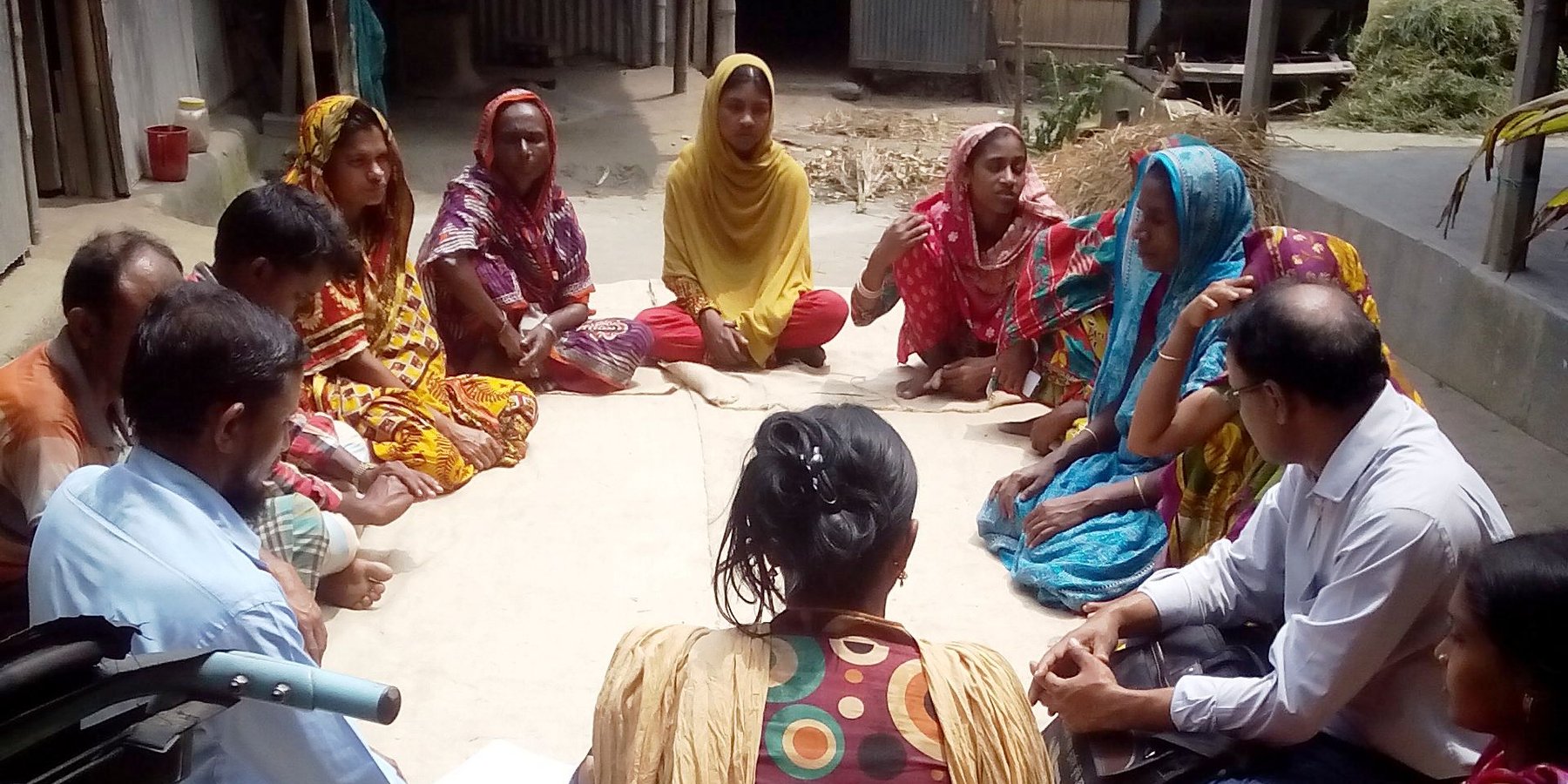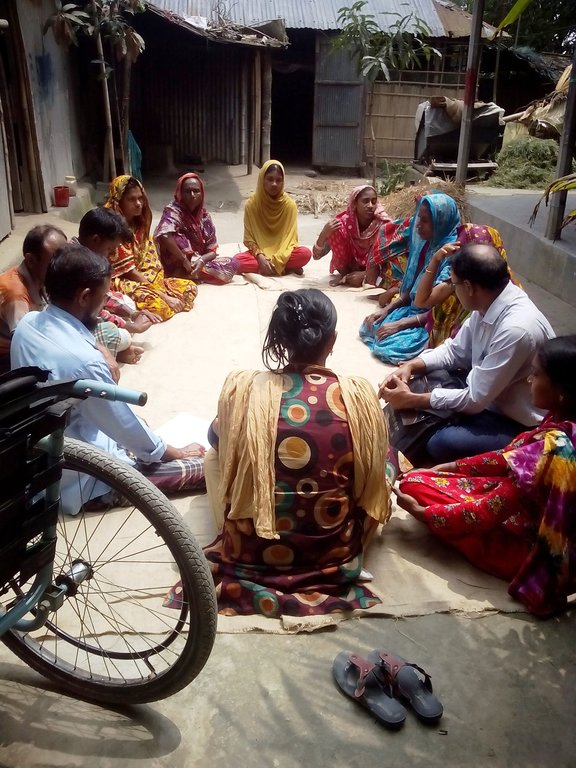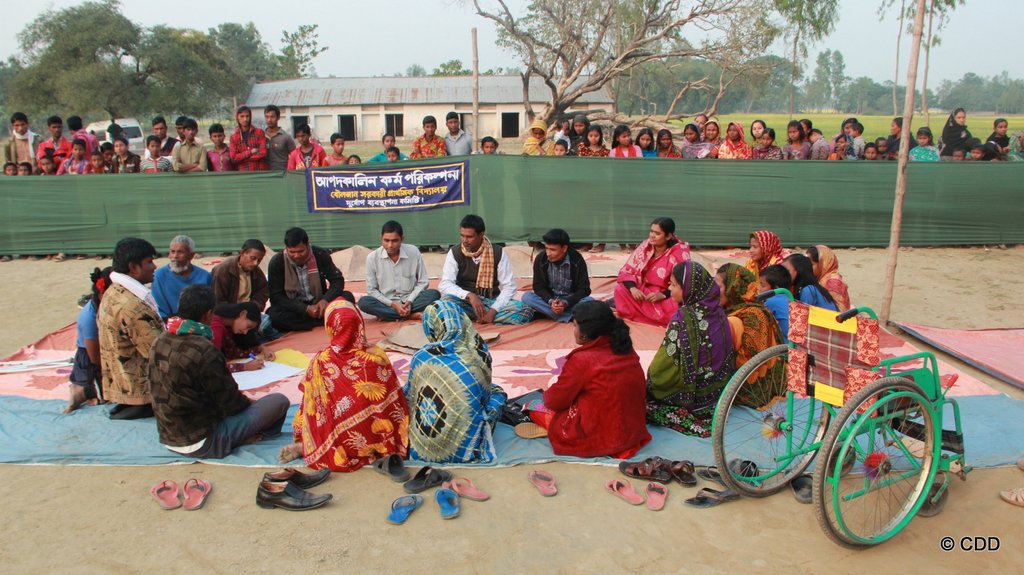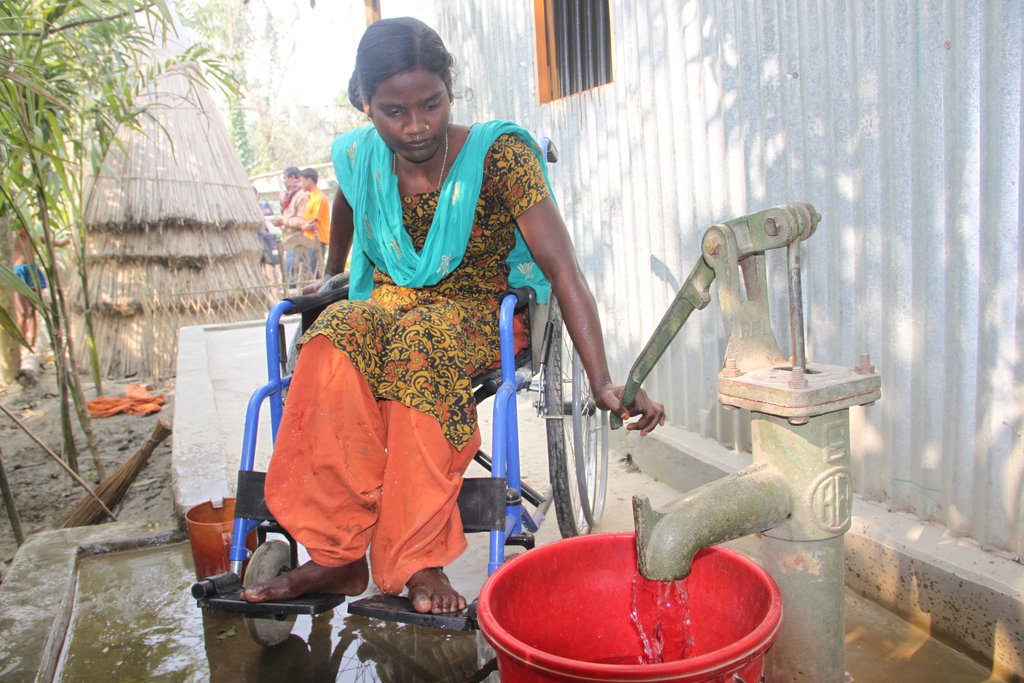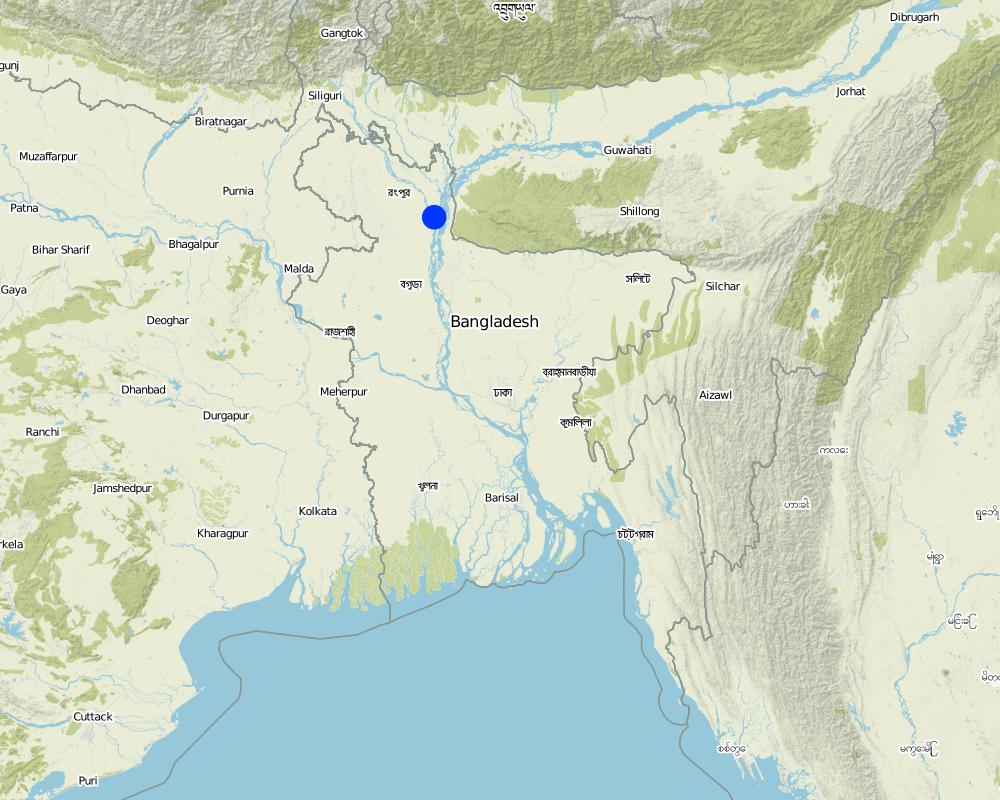Disability inclusive Disaster Risk Reduction [บังกลาเทศ]
- ผู้สร้างสรรค์:
- การอัพเดท:
- ผู้รวบรวม: Subir Saha
- ผู้เรียบเรียง: Manuel Rothe, Subir Saha
- ผู้ตรวจสอบ: Alexandra Gavilano
Protibondhita Bandhob Durjog Jhuki Rash
approaches_2001 - บังกลาเทศ
ดูส่วนย่อย
ขยายทั้งหมด ย่อทั้งหมด1. ข้อมูลทั่วไป
1.2 รายละเอียดที่ติดต่อได้ของผู้รวบรวมและองค์กรที่เกี่ยวข้องในการประเมินและการจัดเตรียมทำเอกสารของแนวทาง
DRR specialist:
Islam Shahidul
+8801733143435
shahidulpls@yahoo.com
Centre for Disability in Development (CDD)
Gaibandha
บังกลาเทศ
DRR specialist:
Dey Ashutosh
880-2-9887251 / +8801787662993
ashutosh.dey@cbm.org
CBM
Country Coordination Office CBM International H # 12 (GF) R # 2/A, Block-F Banani, Dhaka-1213
บังกลาเทศ
DRR Specialist:
ชื่อของโครงการซึ่งอำนวยความสะดวกในการทำเอกสารหรือการประเมินแนวทาง (ถ้าเกี่ยวข้อง)
Book project: where people and their land are safer - A Compendium of Good Practices in Disaster Risk Reduction (DRR) (where people and their land are safer)ชื่อของโครงการซึ่งอำนวยความสะดวกในการทำเอกสารหรือการประเมินแนวทาง (ถ้าเกี่ยวข้อง)
Christoffel Blindenmission (CBM) - สวิตเซอร์แลนด์1.3 เงื่อนไขที่เกี่ยวข้องกับการใช้ข้อมูลที่ได้บันทึกไว้ผ่านทาง WOCAT
วันที่เก็บรวบรวมข้อมูล (ภาคสนาม):
09/11/2016
ผู้รวบรวมและวิทยากรหลักยอมรับเงื่อนไขเกี่ยวกับการใช้ข้อมูลที่ถูกบันทึกผ่านทาง WOCAT:
ใช่
1.4 การอ้างอิงถึงแบบสอบถามเรื่องเทคโนโลยี SLM
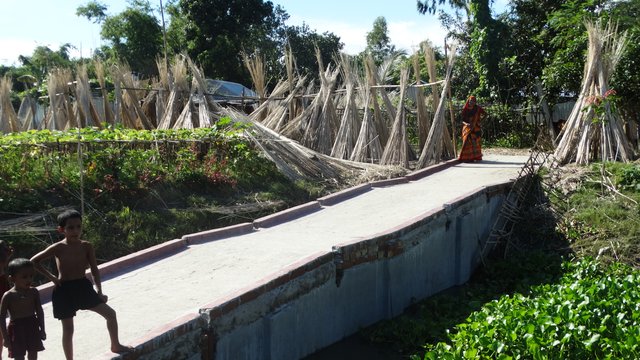
Disability inclusive, flood resilient cluster village [บังกลาเทศ]
The inclusive, flood-resilient cluster village provides safe housing, food security and income generation for multiple families, including persons with disabilities, in a highly flood prone area of Gaibandha District in northern Bangladesh. The land was raised above flood level and is protected by deep rooted fruit trees to prevent soil …
- ผู้รวบรวม: Subir Saha
2. คำอธิบายของแนวทาง SLM
2.1 การอธิบายแบบสั้น ๆ ของแนวทาง
The disability inclusive approach is centered around the meaningful contribution and leadership of persons with disabilties during the entire project management cycle, from the planning stage to the evaluation of the impact of a project. It contributes to empowering them to overcome social exclusion and recognizes their needs and priorities as persons who are disproportionally at risk of disaster.
2.2 การอธิบายอย่างละเอียดของแนวทาง
การอธิบายอย่างละเอียดของแนวทาง:
The main charactistic and central feature of the approach is that persons with disabilties can actively and meaningfully participate in, contribute to and benefit from sustainable land management/disaster risk reduction activities. The implementing organization needs to invest sufficient time and financial ressources into the formation and strenthening of self-representation groups of persons with disabilities and support their active engagement with the local government and the wider community to address the physical and attitudinal barriers that hinder their full participation in the project and society in general.
The aim is twofold: On the one hand, the participation of persons with disabitities ensures that their needs and priorities are fully taken into account in the project design and implementation, to ensure that they can benefit equally from it. On the other hand, it contributes to reducing barriers beyond the project and empowers them to demand their rights in other areas of human development, like education, health or livelihood.
The main stages of disability inclusion in the implementation of a SLM/DRR technology are:
1) Formation of self-help groups for persons with disabilities,
2) trainings and other capacity development activities for the groups, including rights awareness sessions and organizational management trainings,
3) set up the collaboration between the groups and the local government and with other members of the community,
4) participation of persons with disabilities/group members in the planning phase to decide on the technology and adapt the technology to universal design standards, which takes into account their needs and the needs of other groups with other specific accessiblity needs, like the elderly or pregnant women,
5) persons with disabilities (together with other land users) support the introduction of the technology (including the construction activities) by providing manual labor and supervision functions
6) full handover of the technology to land users, ensuring Joint ownership includes persons with disabilities, and provision of trainings for self-maintenance,
7) participation of persons with disabilties in the evaluation of the impact of the technology, sharing of lessons and good practices and continuous advocacy for community development and for the rights of persons with disabilties.
Experience from Bangladesh shows that what the land users, including persons with disabilties, like about the approach is: The strong community engagement, the empowerment and increased status of persons with disabilities, the collaboration between persons with disabilities and persons without disability, and the adaptation of existing technology to fit the needs of persons with disability.
2.3 รูปภาพของแนวทาง
2.5 ประเทศ ภูมิภาค หรือสถานที่ตั้งที่ได้นำแนวทางไปใช้
ประเทศ:
บังกลาเทศ
ภูมิภาค/รัฐ/จังหวัด: :
Gaibandha District
ข้อมูลเฉพาะเพิ่มเติมของสถานที่ตั้ง:
Horipur Union, Sundargonj Sub district
Map
×2.6 วันที่เริ่มต้นและสิ้นสุดของแนวทาง
ระบุปีที่เริ่ม:
2015
การสิ้นสุดลง (ถ้าแนวทางไม่ได้ใช้อีกต่อไป):
2016
ความคิดเห็น:
Project "Disability inclusive, flood resilient cluster village" implemented from December 2015 to September 2016.
2.7 ประเภทของแนวทาง
- ใช้โครงงานหรือแผนงานเป็นฐาน
2.8 เป้าหมายหรือวัตถุประสงค์หลักของแนวทาง
To empower persons with disabilities to meaningfully participate in, contribute to and benefit from the implementation of an SLM/DRR technology.
2.9 เงื่อนไขที่เอื้ออำนวยหรือเป็นอุปสรรคต่อการนำเทคโนโลยีภายใต้แนวทางนี้ไปปฏิบัติใช้
บรรทัดฐานและค่านิยมทางสังคม วัฒนธรรม ศาสนา
- เป็นอุปสรรค
The social stigma and exclusion, that persons with disabilities experience in rural Bangladesh, was a challenge for the project. Persons with disabilities are sometimes believed to be incapable of contributing anything meaningful to society and village life. Some community members did not want to associate with persons with disabilities. This required an extra effort to ensure the participation of the wider community in the project and it required sustained advocacy and awareness raising for the rights and dignity of persons with disabilities.
การมีไว้ให้หรือการเข้าถึงแหล่งการเงินและบริการ
- เอื้ออำนวย
The financial resources for the implementation of the technology and the extra ressources needed to ensure disability inclusion, were readily available because the technology was widely and positively recognized by the community and by donors.
การจัดตั้งระดับองค์กร
- เอื้ออำนวย
The institutional environment was overwhelmingly supportive of the implementation of the project. The local Union Council government, schools, mosques and other civil society organizations were in favor of the technology and approach and supported the implementation.
การร่วมมือหรือการทำงานประสานกันของผู้ลงมือปฏิบัติ
- เอื้ออำนวย
Beneficiaries/land users were selected in a participative process, involving the whole community. The process was transparent and inclusive. It was a foundation for the smooth collaboration with beneficiaries and other involved stakeholders later on.
กรอบแนวทางในการดำเนินการด้านกฎหมาย (การถือครองที่ดิน สิทธิในการใช้ที่ดินและน้ำ)
- เอื้ออำนวย
To ensure joint ownership of beneficiaries of the land on which the SLM/DRR Technology was implemented, an exchange of land was needed. Due to the remoteness and scarce population of the implementation area in rural Bangladesh, a cooperative local government and a manageable legal framework this was easy to achieve.
A deep-rooted tube well was installed for water access of the land users. Water use rights were also easy to acquire.
นโยบาย
- เอื้ออำนวย
No specific policies existed, which significantly affected the implementation of the technology.
การกำกับดูแลที่ดิน (การตัดสินใจ การนำเอาไปปฏิบัติใช้ และการบังคับใช้)
- เอื้ออำนวย
Land ownership was recognized by the local government and land governance was controlled by land owners.
ความรู้เกี่ยวกับ SLM การเข้าถึงการสนับสนุนด้านเทคนิค
- เอื้ออำนวย
Indigenous knowledge about SLM was enabling for the implementation of the technology. Technical expertise by the implementing organization (NGO) was available.
ตลาด (จัดซื้อปัจจัยนำเข้า ขายผลิตภัณฑ์) และราคา
- เอื้ออำนวย
Inputs for construction and planting were locally available at reasonable prices.
ปริมาณงานที่ทำได้ กำลังคนที่มีให้
- เอื้ออำนวย
During the lean season manpower was abundant in the area, but it was scarce during the planting season. The workload for the implementation of the technology was manageable and could easily be provided by land users themselves.
3. การมีส่วนร่วมและบทบาทของผู้มีส่วนได้ส่วนเสียที่เกี่ยวข้อง
3.1 ผู้มีส่วนได้ส่วนเสียที่เกี่ยวข้องในแนวทางนี้และบทบาท
- ผู้ใช้ที่ดินระดับท้องถิ่นหรือชุมชนระดับท้องถิ่น
The land users include 10 families who jointly own and inhabit the land of the cluster village.
Land users were closely engaged in the implementation of the technology by participating in decision making processes, informing the design of the technology and contributing to the construction process.
- องค์กรที่ขึ้นอยู่กับชุมชน
Self-help (self-representation) groups of persons with disabilities are informal community based groups of 15 persons with different types of disabilities (physical-, sensory- and mental disabilities).
The group is closely engaged in the implementation of the technology. It participates in decision making processes, informs the design of the technology, contributes to the construction process, is engaged in the evaluation of the technology and the sharing of learnings about it to the wider community.
The group also provides benefits for its members by supporting them with everyday challenges, which can be of economic, legal or social nature, and promotes the rights of all persons with disabilities in the community.
- องค์กรพัฒนาเอกชน
The implementing NGOs included an international and a local organization in partnership (CBM and CDD).
CDD was responsible for the overall management of project implementation and the collaboration with other involved local stakeholders. CBM provided training and technical support.
- รัฐบาลระดับท้องถิ่น
The Union Parishad government is the lowest level of local government.
The Union Parishad government managed land ownership and approved construction projects.
3.2 การเกี่ยวข้องของผู้ใช้ที่ดินระดับท้องถิ่นหรือชุมชนระดับท้องถิ่นในช่วงต่างๆของแนวทาง
| ความเกี่ยวข้องของผู้ใช้ที่ดินระดับท้องถิ่นหรือชุมชนระดับท้องถิ่น | ระบุผู้ที่มีส่วนเกี่ยวข้องและอธิบายกิจกรรม | |
|---|---|---|
| การริเริ่มหรือการจูงใจ | ปฏิสัมพันธ์ | Land users contributed to the initial situation analysis and joined self-help groups for persons with disabilities. |
| การวางแผน | ปฏิสัมพันธ์ | Land users, and in particular those who are persons with disabilities, participated in all planning and decision making processes related to the design and introduction of the technology, including the selection of the land. |
| การดำเนินการ | จ่ายเงินหรือสนับสนุนจากภายนอก | Land users engaged in the construction of the technology by providing paid and unpaid labor. |
| การติดตามตรวจสอบหรือการประเมินผล | ปฏิสัมพันธ์ | The land users monitored the implementation process and gave feedback to the implementing NGOs when changes were needed. Land users participated in the evaluation of the technology and the approach and contributed to the dissemination of good practices and learnings. |
3.3 แผนผังแสดงขั้นตอนการทำงาน (ถ้ามี)
คำอธิบาย:
Not available.
3.4 การตัดสินใจเลือกใช้เทคโนโลยี SLM
ระบุผู้ที่ทำการตัดสินใจเลือกเทคโนโลยีมากกว่าหนึ่งวิธีไปปฏิบัติใช้:
- ผู้ลงมือปฏิบัติที่เกี่ยวข้องทั้งหมดในฐานะที่เป็นส่วนรวมของแนวทาง
การอธิบาย:
The cluster village technology was known to the community before the implementation. The technology was suggested by the implementing NGOs to the community, which supported its implementation. The technology was adapted to fit the needs of persons with disabilities based on the decisions of land users with technical support of the implementing NGOs.
ระบุว่าการตัดสินใจตั้งอยู่บนพื้นฐานของ:
- การประเมินความรู้ SLM ที่ได้ทำการบันทึกไว้เป็นอย่างดี (การใช้ข้อมูลในการตัดสินใจ)
4. การสนับสนุนด้านเทคนิค การสร้างขีดความสามารถ และการจัดการด้านความรู้
4.1 การสร้างขีดความสามารถ / การอบรม
ได้มีการจัดอบรมให้แก่ผู้ใช้ที่ดินหรือผู้มีส่วนได้ส่วนเสียคนอื่น ๆ หรือไม่:
ใช่
ให้ระบุว่าใครเป็นผู้ได้รับการอบรม:
- ผู้ใช้ที่ดิน
- เจ้าหน้าที่ภาคสนาม / ที่ปรึกษา
ถ้าเกี่ยวข้อง ให้ระบุ เพศ อายุ สถานภาพ ชาติพันธุ์ เป็นต้น:
10 males and 15 females, aged between 18 to 55. Three were persons with disabilities. Most of them were daily laborers and share croppers.
รูปแบบการอบรม:
- กำลังดำเนินการ
- ใช้พื้นที่ทำการสาธิต
- จัดคอร์ส
หัวข้อที่พูด:
On the job training and demonstration on the construction and maintenance of the technology. Training to self-help groups for persons with disabilities on the rights of persons with disabilities, the use and benefits of the technology for persons with disabilities and the management of self-help groups.
ความคิดเห็น:
Training Subjects were: 1) Group dynamics and Development, 2) Disability inclusive DRR 3) Tree plantation and Vegetable Gardening using organic fertilizer 4) Government safety nets and Rights of the persons with disabilities.
4.2 การบริการให้คำแนะนำ
ผู้ใช้ที่ดินมีการเข้าถึงการรับบริการให้คำปรึกษาหรือไม่:
ใช่
ระบุว่ามีบริการให้คำปรึกษาหรือไม่:
- ไปเยี่ยมชมสถานที่
- construction/implementation of technology
การอธิบาย/แสดงความคิดเห็น:
The implementing NGOs provided detailed technical support to land users on the adaptation of the technology to the needs of persons with disabilities, following the standards of universal design.
4.3 การเสริมความแข็งแกร่งให้กับสถาบัน (การพัฒนาองค์กร)
สถาบันได้รับการจัดตั้งขึ้นมาหรือเสริมความแข็งแกร่งโดยแนวทางนี้หรือไม่:
- ใช่ ปานกลาง
ระบุระดับของสถาบันที่ได้รับการเสริมความแข็งแกร่งหรือจัดตั้งขึ้นมา:
- ท้องถิ่น
อธิบายถึงสถาบัน บทบาทและความรับผิดชอบ สมาชิก เป็นต้น:
Local self-help groups and their APEX body (umbrella group) at Union level were strengthened. Their roles of the self-help groups were to establish a mutual support network, raise awareness among group members of disability rights and development issues, pool ressources and give individual persons with disabilities a greater political voice. The APEX body gave the groups contact points beyond their immediate community and gave further weight to their political voice.
ระบุประเภทของการให้ความช่วยเหลือสนับสนุน:
- ด้านการเงิน
- การสร้างขีดความสามารถ / การอบรม
- อุปกรณ์
ให้รายละเอียดเพิ่มเติม :
To strengthen self-help groups, they were provided with, 1) awarness- and skill development trainings, 2) financial support for climate resilient income generation through agricultural and non-agricultural activities, and 3) assistive devices.
4.4 การติดตามตรวจสอบและประเมินผล
การติดตามตรวจสอบและประเมินผลเป็นส่วนหนึ่งของแนวทางหรือไม่:
ใช่
ความคิดเห็น:
A participatory monitoring and evaluation system was implemented with support of the self-help groups for persons with disabilties.
ถ้าตอบว่าใช่ แสดงว่าการจัดเตรียมเอกสารนี้มุ่งหวังที่จะเอาไปใช้สำหรับการติดตามตรวจสอบและประเมินผลใช่หรือไม่:
ไม่ใช่
4.5 การวิจัย
การวิจัยเป็นส่วนหนึ่งของแนวทางหรือไม่:
ไม่ใช่
5. การสนับสนุนด้านการเงินและวัสดุอุปกรณ์
5.1 ระบุงบประมาณประจำปีสำหรับแนวทาง SLM นี้
ระบุงบประมาณประจำปีสำหรับแนวทาง SLM นี้ เป็นหน่วยดอลลาร์สหรัฐ:
218702.00
ถ้าหากว่างบประมาณประจำปีไม่เป็นที่ทราบแน่นอน ให้ระบุช่วงลงไป:
- 10,000-100,000
แสดงความคิดเห็น (แหล่งของการระดมทุน ผู้บริจาคคนสำคัญ):
The annual budget includes the total funds used for the introduction of the technology. Funds were provided through the implementing NGOs CBM and CDD, with the support of a private donor from Germany.
5.2 การสนับสนุนด้านการเงิน / วัสดุอุปกรณ์ให้แก่ผู้ใช้ที่ดิน
ผู้ใช้ที่ดินได้รับการสนับสนุนด้านการเงิน / วัสดุอุปกรณ์ไปปฏิบัติใช้เทคโนโลยีหรือไม่:
ใช่
ถ้าใช่ ให้ระบุประเภทของการสนับสนุน เงื่อนไขและผู้จัดหามาให้:
Land users received a daily fee for the labor provided for the introduction of the technology. The NGOs also provided most material input for the technology, including soil, sand, seeds, seedlings, grass, trees, ramp, water and sanitation facilties.
5.3 เงินสนับสนุนสำหรับปัจจัยนำเข้า (รวมถึงแรงงาน)
- แรงงาน
| เห็นด้วยระดับไหน | ระบุเงินสนับสนุน |
|---|---|
| ได้รับการช่วยเหลือทางการเงินบางส่วน | Labor provided by land users for certain construction actvities was compensated with a daily fee. |
- อุปกรณ์
| ระบุปัจจัยนำเข้าที่ได้รับการสนับสนุน | เห็นด้วยระดับไหน | ระบุเงินสนับสนุน |
|---|---|---|
| เครื่องจักร | ได้รับการช่วยเหลือทางการเงินแบบเต็ม | Rent of sand extravation machine was funded by the project. |
| เครื่องมือ | ได้รับการช่วยเหลือทางการเงินแบบเต็ม | Tools for construction activities was provided to land users by the project. |
- การเกษตร
| ระบุปัจจัยนำเข้าที่ได้รับการสนับสนุน | เห็นด้วยระดับไหน | ระบุเงินสนับสนุน |
|---|---|---|
| เมล็ด | ได้รับการช่วยเหลือทางการเงินแบบเต็ม | Seeds and seedlings for the homestead garden was provided by the project. |
| ปุ๋ย | ได้รับการช่วยเหลือทางการเงินบางส่วน | The facility for composting organic fertilizer was provided by the project. |
| Plants | ได้รับการช่วยเหลือทางการเงินแบบเต็ม | Deep-rooted fruit trees and grass turfing was provided by the project. |
- วัสดุสำหรับการก่อสร้าง
| ระบุปัจจัยนำเข้าที่ได้รับการสนับสนุน | เห็นด้วยระดับไหน | ระบุเงินสนับสนุน |
|---|---|---|
| ไม้ | ได้รับการช่วยเหลือทางการเงินบางส่วน | Wood for fencing for the homestead vegetable garden in front of all houses and a flood resilient cow sheds in the village was provided by the project. |
| Soil | ได้รับการช่วยเหลือทางการเงินแบบเต็ม | The purchase of soil for the raising of land was funded by the project. |
- โครงสร้างพื้นฐาน
| ระบุปัจจัยนำเข้าที่ได้รับการสนับสนุน | เห็นด้วยระดับไหน | ระบุเงินสนับสนุน |
|---|---|---|
| ถนน | ได้รับการช่วยเหลือทางการเงินบางส่วน | Construction material for barrier free connections to all houses in the village was funded by the project. |
| Ramp | ได้รับการช่วยเหลือทางการเงินแบบเต็ม | A ramp, connecting the cluster village with the road was funded by the project. |
ถ้าแรงงานโดยผู้ใช้ที่ดินเป็นปัจจัยนำเข้าที่มีอยู่มากมาย ระบุด้วยว่าเนื่องจาก:
- จ่ายเป็นเงินสด
ความคิดเห็น:
A daily fee of 300 Taka was provided for labor inputs by the land users.
5.4 เครดิต
มีการจัดหาเครดิตมาให้ภายใต้แนวทาง SLM หรือไม่:
ไม่ใช่
5.5 แรงจูงใจหรือเครื่องมืออื่น ๆ
แรงจูงใจหรือเครื่องมืออื่น ๆ ได้ถูกนำไปใช้ส่งเสริมการใช้เทคโนโลยี SLM หรือไม่:
ไม่ใช่
6. การวิเคราะห์ผลกระทบและการสรุป
6.1 ผลกระทบของแนวทาง
ทำให้ผู้ใช้ที่ดินระดับท้องถิ่นมีอำนาจขึ้น ปรับปรุงการเข้าร่วมของผู้มีส่วนได้ส่วนเสียให้ดีขึ้นหรือไม่:
- ไม่ใช่
- ใช่ เล็กน้อย
- ใช่ ปานกลาง
- ใช่ อย่างมาก
The approach is based on the empowerment of land users, in particularly those who are persons with disabilites. It ensured participation of persons with disablities who would otherwise be isolated and excluded.
ช่วยในการตัดสินใจโดยดูจากหลักฐาน ได้หรือไม่:
- ไม่ใช่
- ใช่ เล็กน้อย
- ใช่ ปานกลาง
- ใช่ อย่างมาก
ช่วยให้ผู้ใช้ที่ดินนำเอาเทคโนโลยี SLMไปใช้และบำรุงรักษาสภาพไว้ได้หรือไม่:
- ไม่ใช่
- ใช่ เล็กน้อย
- ใช่ ปานกลาง
- ใช่ อย่างมาก
The project supported land users with the implementation and use of the technology.
ปรับปรุงความร่วมมือกันและการดำเนิน งานของ SLM ได้อย่างมีประสิทธิผลหรือไม่:
- ไม่ใช่
- ใช่ เล็กน้อย
- ใช่ ปานกลาง
- ใช่ อย่างมาก
The coordination among land users has improved and actions of land management have become more cost effective.
ระดมกำลังหรือปรับปรุงการเข้าถึงแหล่ง เงินทุนสำหรับการดำเนินการ SLM หรือไม่:
- ไม่ใช่
- ใช่ เล็กน้อย
- ใช่ ปานกลาง
- ใช่ อย่างมาก
ปรับปรุงความรู้และความสามารถของผู้ใช้ที่ดินในการดำเนินการ SLM หรือไม่:
- ไม่ใช่
- ใช่ เล็กน้อย
- ใช่ ปานกลาง
- ใช่ อย่างมาก
Land users were provided with trainings and demonstrations about the implementation and use of the technology.
ปรับปรุงความรู้และความสามารถของผู้มีส่วนได้ส่วนเสียคนอื่น ๆ ให้ดีขึ้นหรือไม่:
- ไม่ใช่
- ใช่ เล็กน้อย
- ใช่ ปานกลาง
- ใช่ อย่างมาก
The local goverment, other members of the community and other non-governmental organizations took note of the technology and sensitization about the rights and needs of persons with disabilties increased.
ทำให้ผู้ใช้ที่ดินระดับท้องถิ่นมีอำนาจขึ้น ปรับปรุงการเข้าร่วมของผู้มีส่วนได้ส่วนเสียให้ดีขึ้นหรือไม่:
- ไม่ใช่
- ใช่ เล็กน้อย
- ใช่ ปานกลาง
- ใช่ อย่างมาก
The approach strengthened the collaboration between the local government and self-help groups of persons with disabilities.
ช่วยบรรเทาความขัดแย้งหรือไม่:
- ไม่ใช่
- ใช่ เล็กน้อย
- ใช่ ปานกลาง
- ใช่ อย่างมาก
Joint decision making and the resolution of conflicts among land users improved through the joint managment of the land.
ทำให้กลุ่มด้อยโอกาสมีอำนาจทางสังคมและเศรษฐกิจหรือไม่:
- ไม่ใช่
- ใช่ เล็กน้อย
- ใช่ ปานกลาง
- ใช่ อย่างมาก
The approach empowered persons with disabilities and other land users, who all belonged to economically marginalized groups. Their social and economic status greatly improved.
ปรับปรุงความทัดเทียมกันด้านเพศและให้อำนาจแก่ผู้หญิงและเด็กผู้หญิงหรือไม่:
- ไม่ใช่
- ใช่ เล็กน้อย
- ใช่ ปานกลาง
- ใช่ อย่างมาก
Land user participation in the implementation of the technology always included men and women. Self-help groups for persons with disabilities, which were formed and strengthened by the project, always included around 50% women. Meaningful participation by women in group meetings was promoted by the implementing NGOs.
ส่งเสริมให้เยาวชนหรือบุตรหลานของผู้ใช้ที่ดินให้เข้าร่วมใน SLM:
- ไม่ใช่
- ใช่ เล็กน้อย
- ใช่ ปานกลาง
- ใช่ อย่างมาก
The technology was of of high interest for youth clubs, high school students and other young people in the community and many voiced the intention of replicating it in the future.
ปรับปรุงประเด็นของการถือครองที่ดินหรือสิทธิในการใช้ ซึ่งขัดขวางการนำเทคโนโลยีไปใช้ให้ดีขึ้น:
- ไม่ใช่
- ใช่ เล็กน้อย
- ใช่ ปานกลาง
- ใช่ อย่างมาก
นำไปสู่ความมั่นคงด้านอาหารหรือปรับปรุงโภชนาการให้ดีขึ้น:
- ไม่ใช่
- ใช่ เล็กน้อย
- ใช่ ปานกลาง
- ใช่ อย่างมาก
The technology improved food security and nutrition through the introduction of fruit tree plantation and a homestead vegetable garden.
ปรับปรุงการเข้าถึงตลาดหรือไม่:
- ไม่ใช่
- ใช่ เล็กน้อย
- ใช่ ปานกลาง
- ใช่ อย่างมาก
The construction of a ramp for road access allows wheelchair users and other persons with limited mobility to better access local markets.
นำไปสู่การเข้าถึงเรื่องน้ำและสุขาภิบาลได้ดีขึ้นหรือไม่:
- ไม่ใช่
- ใช่ เล็กน้อย
- ใช่ ปานกลาง
- ใช่ อย่างมาก
The technology improved water access through the drilling of a deep bore hole water source for common water access and the construction of barrier free household latrines.
นำไปสู่การใช้ที่ดินอย่างยั่งยืนหรือแหล่งพลังงานหรือไม่:
- ไม่ใช่
- ใช่ เล็กน้อย
- ใช่ ปานกลาง
- ใช่ อย่างมาก
The technology lead to more sustainable energy use through the provision of household based mini solar systems.
ปรับปรุงความสามารถของผู้ใช้ที่ดินในการปรับตัวให้เข้ากับการเปลี่ยนแปลงของสภาพภูมิอากาศหรือสภาพที่รุนแรงและภัยพิบัติหรือไม่:
- ไม่ใช่
- ใช่ เล็กน้อย
- ใช่ ปานกลาง
- ใช่ อย่างมาก
The technology offers a safe and accessible space for housing, fruit and vegetable cultivation and livestock shelter. It greatly improved the capacity of land users to adapt to the increasing occurence and intensity of monsoon floods.
นำไปสู่โอกาสในการจ้างงาน รายได้หรือไม่:
- ไม่ใช่
- ใช่ เล็กน้อย
- ใช่ ปานกลาง
- ใช่ อย่างมาก
The technology improved income opportunities through the introduction of a flood resilient fruit tree plantation and homestead vegetable garden. Part of the harvest can be sold on the market.
6.2 แรงจูงใจหลักของผู้ใช้ที่ดินเพื่อที่จะนำ SLM ไปปฏิบัติใช้
- การผลิตที่เพิ่มขึ้น
Vegetable production and fruit production increased and is more flood resilient.
- การเสื่อมของที่ดินลดลง
Soil erosion and land degradation in the custer village reduced.
- ความเสี่ยงของภัยพิบัติลดลง
Reduction of disaster risk was the main motivating factor for land users. The cluster village is a flood-resilient safe-place providing shelter for the whole community, including their livestock, during flood season.
- ภาระงานลดลง
Household works and household based income generating activities have become easier to organize because of the safety and reliable energy supply that the cluster village provides.
- การเข้าร่วมสมทบในขบวนการ โครงการ กลุ่ม เครือข่าย
Joint ownership of the cluster village by land users, who all belonged to an economically marginalized part of the community (daily laborers and share-croppers) and the formation of self-help groups for persons with disabilities, have greatly improved social cohesion among land users.
6.3 ความยั่งยืนของกิจกรรมของแนวทาง
ผู้ใช้ที่ดินสามารถทำให้สิ่งต่างๆ ที่ได้ปฏิบัติใช้โดยแนวทางนี้ยั่งยืนได้หรือไม่ (โดยไม่มีการสนับสนุนจากภายนอก):
- ไม่แน่ใจ
ถ้าตอบว่าไม่หรือไม่แน่ใจ ให้ระบุและแสดงความคิดเห็น :
The maintenance of the cluster village (including grass turfing, tree plantation, vegetable garden, solar panels, water and sanitation facilities) is currently managed by land users themselves . Long-term sustainability cannot be evaluated yet.
6.4 จุดแข็งและข้อได้เปรียบของแนวทาง
| จุดแข็ง / ข้อได้เปรียบของแนวทางในทัศนคติของผู้ใช้ที่ดิน |
|---|
| Land users greatly apprechiate the empowerment and social cohesion that the approach enabled. Decisions are taken together and conflicts in the village can be mitigated. The Cluster Village has become a safe space and meeting point for the whole community. |
| The Cluster Village is fully inclusive of persons with disabilities (inclusion in decision making processes and social activities and fully accessible infrastructure), which is something that land users are proud of because it is the first such set-up in the community and is apprechiated as a model by others. |
| จุดแข็ง / ข้อได้เปรียบของแนวทางในทัศนคติของผู้รวบรวมหรือวิทยากรหลัก |
|---|
| Meaningful participation and of persons with disabilities in project implementation has a signaling effect beyond the project and fosters sensitization of the local government and wider community for more inclusive community development and principles of universal design. |
| Formation of self-help groups of persons with disabilities and their active engagement with the wider community on community development issues, which go beyond the rights and needs of persons with disabilites, lead to empowerment and geater social inclusion of persons with disabilities. |
6.5 จุดอ่อน / ข้อเสียเปรียบของแนวทางและวิธีในการแก้ไข
| จุดอ่อน / ข้อเสียเปรียบในทัศนคติของผู้ใช้ที่ดิน | สามารถแก้ไขปัญหาได้อย่างไร |
|---|---|
| Technical knowledge gap when it comes to the maintenance of the technology and the continuous dependence on external support. | Invest sufficient ressources in trainings and capacity building and emphasis and formalize the transfer of ownership of the technology to land users. |
| จุดอ่อน / ข้อเสียเปรียบในทัศนคติของผู้รวบรวมหรือวิทยากรหลัก | สามารถแก้ไขปัญหาได้อย่างไร |
|---|---|
| Formation and strenthening of self-help groups of persons with disabilties to the level where they are sustainable and able to make significant contributions to the projects and community development and demand their rights, takes significant ressources with regard to time and funds invested. | Strong committment of the implementing organization to inclusive programming and sufficient internal capacity building. |
7. การอ้างอิงและการเชื่อมต่อ
7.1 วิธีการหรือแหล่งข้อมูล
- ไปเยี่ยมชมภาคสนาม การสำรวจพื้นที่ภาคสนาม
6
- การสัมภาษณ์กับผู้ใช้ที่ดิน
10
- การสัมภาษณ์ผู้เชี่ยวชาญด้าน SLM หรือผู้ชำนาญ
2
- การเก็บรวบรวมมาจากรายงานและเอกสารที่มีอยู่
5
7.2 การอ้างอิงถึงสิ่งตีพิมพ์
ชื่อเรื่อง ผู้เขียน ปี ISBN:
Disability inclusive disaster risk managment, CBM, 2013
ช่องทางในการสืบค้น และราคา:
http://www.cbm.org/article/downloads/54741/Disability_Inclusive_Disaster_Risk_Management.pdf
ลิงก์และโมดูล
ขยายทั้งหมด ย่อทั้งหมดลิงก์

Disability inclusive, flood resilient cluster village [บังกลาเทศ]
The inclusive, flood-resilient cluster village provides safe housing, food security and income generation for multiple families, including persons with disabilities, in a highly flood prone area of Gaibandha District in northern Bangladesh. The land was raised above flood level and is protected by deep rooted fruit trees to prevent soil …
- ผู้รวบรวม: Subir Saha
โมดูล
ไม่มีโมดูล


